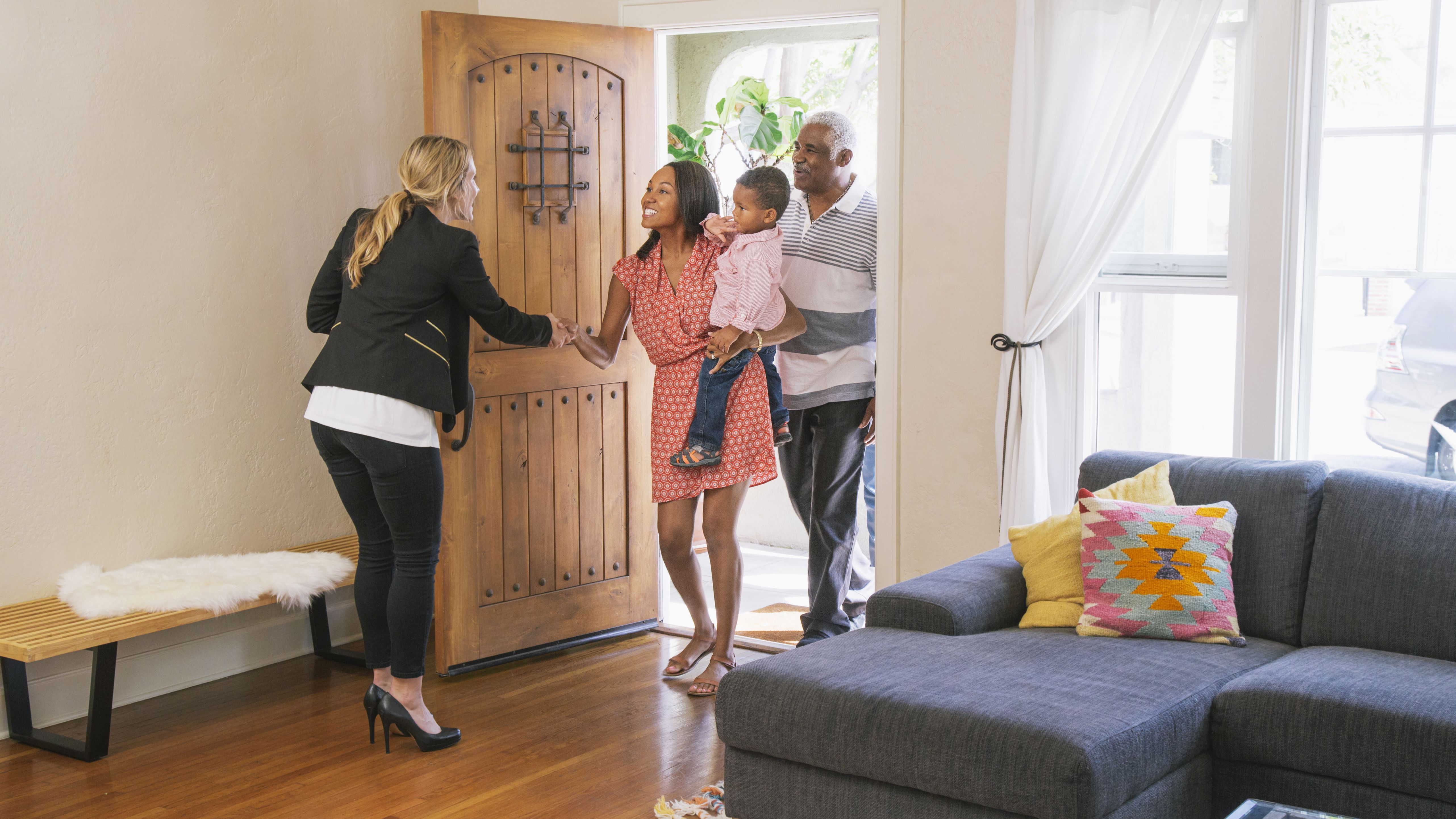
How To Prepare For An Open House
Pare down and organize your belongings
Buyers want to be able to visualize themselves—and their things—in your home. Make this task easier for them by simplifying the space. When it comes to preparing for an open house, less (stuff) is more.
Get rid of excess furniture: Oversized or too much furniture can make even spacious rooms seem small and crowded. Give your home some breathing room by removing excess pieces.
Declutter: Clutter is a major distraction when buyers are walking through a home. You want them to focus on all the great features of the house, not stare at the mountain of unfolded laundry in the corner of the closet or the stack of mail cluttering up the kitchen counter.
Depersonalize: In addition to clearing out the clutter, you’ll want to do some depersonalization, removing items like framed family photos and memorabilia. It’s hard for a buyer to picture living in the home if they see photos of you around every corner.
Organize closets and cupboards: According to the Group Consumer Housing Trends Report, almost half of all recent buyers list ample storage as a requirement. Even if your home has plenty of closets, storage areas, and pantry space, if every nook and cranny is filled to the brim, it’ll give the impression that there’s not enough space. Take at least half of the belongings from each storage area and box them up.
Consider open house staging: Hiring a stager can be as simple as having a professional walk through your home and make recommendations for DIY changes, or as involved as hiring a full-service staging company to create a whole new look for your home. A consultation can cost between $100 and $150 an hour, and full-fledged staging is either charged on a per-room basis ($250 to $500 per room) or occasionally as a fee of 1% to 3% of the final sale price. There are plenty of staging tips you can implement on your own, too.
Deep clean for a fresh look and smell
Now that you’ve cleared out the excess and organized what’s left, it’s time to make it sparkle. There’s no better way to show buyers you’ve taken good care of your home than for it to be spotless!
Hire a cleaning service: If you’re too busy with the many other tasks that come with getting your house ready to sell, consider hiring a cleaning service (and maybe a professional organizer!) to come in and do a one-time deep clean of the home, from baseboards to backsplashes and closets to cobwebs.
Professionally shampoo carpets: There’s nothing worse than dingy, dirty carpets. A professional carpet cleaning will give new life to tired carpets and make your home smell fresh and new.
Wash the windows: Natural light is a huge selling feature, and you’ll be surprised how much extra light you can let in just by cleaning the windows — both inside and out.
Clean up the front entrance: The walkway up to your property and the front entrance are your home’s first impression. Power wash outside, touch up paint in the entryway, and clear out any dirt and grime that has collected around the edges.
Don’t overdo it with scents: A newly cleaned home will smell good on its own, so don’t rely heavily on air fresheners and candles. Strong smells can be a turn off to some buyers, and they might think you’re trying to mask something smelly.
Make necessary repairs
Buying a home is a huge investment, so you better bet that potential buyers are looking at your home with a critical eye. It’s always worth the time to make a few repairs, especially if there are any true eyesores.
Paint: Adding a fresh coat of paint throughout the home is one of the easiest things you can do to spruce up your listing. Make sure to use a neutral color that will appeal to most buyers.
Address cosmetic issues: Adding a fresh layer of caulking in the bathroom, patching holes in walls, and replacing light bulbs can help potential buyers focus on what they like about your home, instead of fixating on small — but obvious — issues.
Tackle outdoor spaces: Prune any overgrown landscaping, cut back tree branches, and mow the lawn.
Focus on curb appeal: Make sure the home is making a good first impression. Fix torn window screens, repair loose gutters, and power wash the driveway and/or walkway.
Strengthen the online listing
Once you’ve organized, cleaned, and repaired, you’ll want to make sure the listing itself reflects all your hard work! A great online listing is the best way to get potential buyers through the door for your open house.
Add a video: A virtual tour or video is a wonderful way to make your property stand out, and it’s never been easier to create your own. Try 3D Home, which lets you create a 3D tour with your iPhone.
Include a drone-captured photo or video: Give buyers a birds-eye view of your property and the surrounding neighborhood with a photo or video taken by drone.
Use more photos: According to research, a home with fewer than nine photos is about 20% less likely to sell in 90 days than a home with 22 to 27 photos. So, aim for two dozen really great images of your listing.
Promote the open house
If you want your open house to be packed with people, it’s crucial to make sure everyone knows when it’s happening and how to find it. Open house advertising comes in many forms, including traditional and digital methods.
Add it to your listing: Have your real estate agent add your open house to the listing, which will also make it show up on other online real estate sites.
Post signs: Add an “Open house Saturday” sign to your existing real estate signs, place an additional sign in the front yard, and use plenty of directional signs to help people easily find the house, especially on main roads.
Use balloons: On the day of the open house, tie balloons to the signs to catch the attention of both passers-by and those who are seeking out your open house.
Be smart about timing: Most open house times are from 1 to 3 p.m. Start yours at noon or run until 5 so you aren’t directly competing with every other open house in the neighborhood.
Open house etiquette
Offer food and drinks: A friendly atmosphere invites potential buyers and their agents to stay and chat.
Open curtains and blinds: Let in the natural light (through your clean windows!) wherever you can.
Close toilet seats: Enough said.
Pull cars out of the garage and driveway: This will highlight storage inside the garage and give buyers an unobstructed view of your home from the curb.
Remove all signs of your pet: In the same way that you should depersonalize, tuck away your pet’s toys, bowl, and bed. Not everyone is a pet person.
Secure valuables and medication: Unfortunately, open houses are a target for thieves. Remove valuables like jewelry, plus all prescription medication, before the event.
Hit the road: Unless you’re selling your home yourself, leave the actual hosting of the open house to your real estate agent. Buyers will feel more comfortable walking through the home and will speak more freely about their impressions if they know the owner isn’t present.
Provide flyers: Most buyers hit up multiple open houses in a weekend, so you’ll want to make sure they remember yours. Hand out flyers that include all the key details, like list price, important facts, key features, and photos.
Have comps available: If your attendees are serious buyers, your open house probably isn’t their only stop that day. Have printouts of nearby comparable homes so you or your agent can speak to their similarities and differences.
Get feedback: The people who attend your open house are an incredible resource. Have your agent follow up with their agent to get their honest feedback on the home — good or bad. Alternatively, consider having buyer feedback cards on site.
Coping with the stress
Putting your house on the market can be a stressful experience, especially when you consider the added pressure of inviting strangers into your home during an open house. Luckily, real estate agents are experts in the entire listing process, so ask your agent to take the lead on most of these open house tips and manage the private showings that will likely follow
